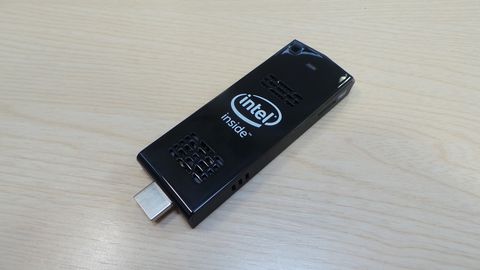TechRadar Verdict
The Compute Stick is a niche product – one that will have fans and detractors. It has flaws and compromises, and far too many to make it an indisputable 'buy now' product. Wait until the next version, and we shall reconsider our verdict.
Pros
- +
Tiny form factor
- +
Can tweak BIOS
- +
Value for money
Cons
- -
Form factor is controversial
- -
Fan isn't ideal
- -
Performance wasn't impressive
Why you can trust TechRadar
Intel's Compute Stick will certainly go down in history as the first complete personal computer that the Santa Clara company, better known for manufacturing processors, has shipped to end users.
The firm has been dabbling with barebones kits and DIY products (like its NUCs) for ages, but this is the first time I can remember it shipping something that can be used out of the box (without having to add an OS, memory and storage). It will, as many other experts have commented, send waves across the entire technology industry.
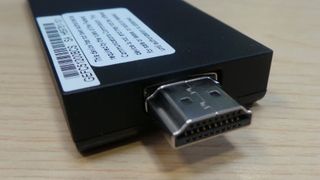
Intel is not the first big name in tech to come up with such a device. Dell's Wyse Cloud Connect used an ARM processor and Android instead of an Intel one and Windows (the Compute Stick is also available with Ubuntu 14.04 LTS, as well). Over the last 24 months, we've seen a flurry of these HDMI-connected Android/ARM-based dongles grow in popularity in South East Asia with prices plummeting to about £20 (around $32, AU$40).
For that price, you get a tiny device barely bigger than a pack of chewing gum, with hardware equivalent to the first generation Google Nexus 7, minus the battery, screen and the camera.
Unlike Google's Chromecast, these devices are actual computers, not just extensions of your tablet or smartphone. It is these Android-based dongles that Intel is targeting and the Compute Stick might provide its closest partners with the blueprint to start from.
However, the Compute Stick is anything but cheap, and as such, doesn't aim to be a mass seller. UK retailer Dabs sells the one with Windows preloaded for £130 and the suggested retail price in the US is $150. A deliberate strategy to foster a nascent Intel-based dongle portfolio? Possibly.
Design and specifications
Note that the product which was sent to us is a pre-production engineering sample. This means that the final iteration might differ slightly from the one we're reviewing today.

This is a computer that's supposed to be hidden away all the time. With that in mind, don't expect it to win any beauty competitions – Intel designed it to be functional. The device's dimensions – 103 x 37 x 12mm – are such that it can be slipped easily into a jeans pocket. There are also plenty of air vents in the front of the device (which sports a massive 'Intel Inside' logo) and on the side. That's because the processor inside the Compute Stick warms up quite a bit; a fan has also been added to dissipate the heat more effectively.
There's a power button, a micro-USB slot (for power), a full-size USB 2.0 port, a status light, a microSD card slot and a full-size HDMI port. The size of the device could be an issue as users risk running into trouble if the ports on their monitor are located right next to each other and are already occupied – that explains Intel's decision to throw in an HDMI extender cable.
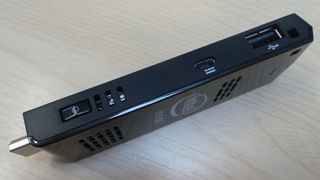
The rest of the specification sheet includes an Atom Z3735F processor, one that is usually found in countless Windows tablets around the world. It's a quad-core Bay Trail model that runs at 1.33GHz, peaking at 1.83GHz, plus on the same die, there's an Intel HD Graphics subsystem running at 311MHz.
There's also 2GB of DDR3L 1333MHz memory, 32GB of flash memory from Samsung (about 23GB of which is free), Wi-Fi, Bluetooth 4.0 and Windows 8.1 with Bing (32-bit), which can be upgraded for free to Windows 10 when it's launched later this year. Note that the cheaper Ubuntu model has only 1GB of RAM and 8GB of onboard storage.
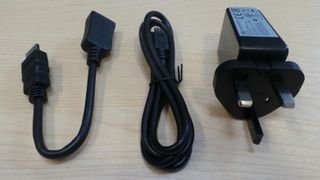
Also in the package are a 10W adapter (the same as most tablets), a USB Type A to micro-USB cable and an assortment of detachable power plugs. Interestingly, you can access the device's BIOS by pressing the appropriate keyboard key – hidden in the menu is the ability to toggle the performance between low-power, balanced and performance, which raises the baseline processor speed and, well, the general performance level.
Performance
Intel cited home entertainment, PC-like embedded, productivity and thin client as the four main usage models for this device. Futuremark's PCMark 8 and 3DMark 2013 proved that the Compute Stick is only adequate for very light usage scenarios as the device struggled during benchmark tests.
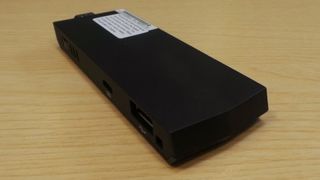
It failed to run some tests (Fire Strike and PCMark 8 Creative) and the rest of the results only served to reinforce my belief that the Compute Stick is not capable of doing any sort of heavy lifting in terms of resources.
The benchmark results were as follows:
- 3DMark 2013 Cloud Gate: 1154
- 3DMark 2013 Ice Storm: 12450
- PCMark 8 Home: 1082
- PCMark 8 Work: 1436
To put this in perspective, it performed slightly worse than the Intel NUC we reviewed last year.

Désiré has been musing and writing about technology during a career spanning four decades. He dabbled in website builders and web hosting when DHTML and frames were in vogue and started narrating about the impact of technology on society just before the start of the Y2K hysteria at the turn of the last millennium.
